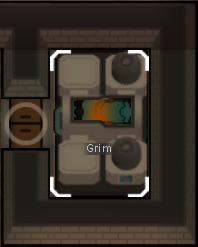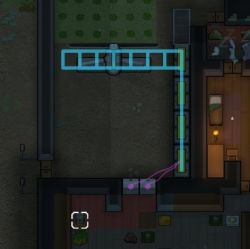Difference between revisions of "Structure"
(Created page with "In '''RimWorld''', your colonists are able to build structures from the ground up, according to the blueprints you decide.<br> The following structures are available: {| |- st...") |
Malganis75 (talk | contribs) m (Added construction nav) |
||
| Line 8: | Line 8: | ||
|{{:Sandbags}} | |{{:Sandbags}} | ||
|} | |} | ||
| + | |||
| + | {{Nav_construction | ||
| + | }} | ||
Revision as of 14:32, 27 October 2013
In RimWorld, your colonists are able to build structures from the ground up, according to the blueprints you decide.
The following structures are available:
Door Divides rooms. Simple doors must be manually opened, which slows people down. The amount of slowdown depends on what the door is made of. Base Stats Building
Creation
Doors provide entry points through walls for colonists while still keeping out enemies and wild animals. Acquisition
Constructing a door requires and Expression error: Unexpected < operator. of work. Summary
Doors mostly act like walls. Doors are valid structures for supporting roofs and creating rooms. Opening a door will allow access and make heat transfer faster. Note that the room is still considered enclosed for temperature mechanics. So, unlike a hole in the wall, an open door will not equalize temperature instantly with the outdoors. Floor under a door does not count towards a rooms' stats, but filth on that tile does count. Doors do not block the interaction spots of buildings. Opening a door take a small amount of time, dependent on the material. Doors can be opened by colonists, slaves Doors can be held open by selecting the door and toggling the gizmo marked as such. The door will not open or close automatically. Instead, a held open door will simply not close after the next friendly pawn opens it, and a held open door toggled off will close after the next pawn walks through it. Doors can also be forbidden, again by selecting the door. Colonists and other colony-controlled pawns will not pass through it, even if open. However, colonists under a mental break will ignore restrictions, as do visitors, traders, and enemies. Enemy behaviorIn general, humanoid and mechanoid raiders treat a closed door like a wall. Most raiders will only try and break one if there are no other paths to their target. Sappers and breachers can break doors intentionally. Doors have less HP than walls, so tend to be prioritized. Retreating enemies will often break down doors in their path out, even if they have higher HP than the surrounding walls. The exact mechanics behind this are unknown. Manhunter animals will only try and break doors if they see something go inside it. Prisoners who have gone berserk will try and break out, while those in a prison break "have broken the locks" and can just open them. Unclaimed doors, like those in ruins, can be opened by any non-animal until they are claimed. Doors owned by an enemy must be claimed (which requires defeating said enemy) in order for colonists to open them. AnalysisMaterial choiceWood is plentiful in most biomes, easy to construct, and quick to open, so a newer colony will typically make all of their doors out of it. However, it is both flammable and not especially durable, so are prone to destruction. Later on, wood is still useful for internal structures, where their health doesn't really matter. Steel doors are moderately expensive. They are still vulnerable to fire, but have more health and open reasonably quickly. Once you can afford them, they are a decent upgrade to wood. Uranium and then plasteel have even more health, but are expensive materials, so should be reserved for prisons and active combat zones. Stone doors open very slowly. However, they are cheap, durable and have 0% flammability. Use stone doors in places where colonists won't travel a lot, such as a burning room, battery compartment, or a geothermal generator room. Granite is the hardiest rock, and no slower than any other stone. Once autodoors have been researched, and you have the power and component supplies to reliably operate them, standard doors can be replaced with alternative materials and not slow down traffic at all, or at least slow it far less. Temperature regulationWhen creating temperature controlled spaces, such as freezers, two doors can be used to create an 'airlock' to improve insulation and reduce temperature equalization, similar to double thick walls. The two doors should be placed in the path of travel, not side by side, and ideally a single tile space is placed between the doors. If they are placed directly adjacent to each other both doors will be open at the same time as a pawn walks through them, allowing more heat to get out, though it will still perform better than a single door on average. On the other hand, open doors can increase temperature equalization, either with another room or the outdoors. Equalization through open doors is less potent than vents.[Verify] Mini-roomsBecause doors do not block the interaction spots of buildings, it's possible to build "mini-rooms" that are only large enough for the building itself, with the door at the interaction spot. Mini-rooms are best used for buildings that don't damage pawn mood when used in cramped quarters, such as cryptosleep caskets and biosculpter pods These rooms are especially useful for biosculpter pods: mini-rooms only require 6 tiles of sterile tile per pod for maximum cleanliness. Note that while the door's tile does not need to be sterile tile itself, it does need to be kept free of dirt for the best bonus to apply. The door can be held open to maximize speed of access for nutritional loading or emergency medic cycles while still maintaining the cleanliness bonus Stats table
Version history
|
See also: Waterproof conduit Power conduit A bundle of electrical cables for moving power around. Can be placed under walls and other buildings. Base Stats
Building
Creation
Note that, unlike most other construction, when deconstructed, power conduit has 0% chance to produce any valuable material. AcquisitionPower conduits can be constructed once the [[Research#|]] research project has been completed. They require and Expression error: Unexpected < operator. of work. SummaryPower conduits transport power. There must be a direct connection to a conduit, power switch, battery, or other power transmiting device for a conduit to be able to transport power. However, electric appliances, such as an electric stove, can link up to a conduit, battery, or generator up to 6 tiles away. Anything with the "Reconnect" gizmo can attach to a distant conduit, but conduits can't attach to a distant conduit. Conduits can be placed under walls and doors, which hides their -2 beauty penalty. In addition, raiders must break the wall before the conduit can be attacked, which usually makes the conduit a very low priority target. Short circuitA conduit can short circuit, damaging a random piece of conduit and discharging all connected stored power from batteries, in an explosion proportional to the amount of charge. This damage can be mitigated by building walls over your power conduits (reducing the spread of fires), keeping critical areas and storage away from conduits, and disconnecting charged banks of batteries from the network via a power switch. Conduits do not short circuit in the rain, though other appliances can. AnalysisConduits in some form are practically required to use electricity, however using power conduits specifically opens the risk of random short circuits. It is possible to connect appliances directly to a generator or battery to avoid using any conduits. Otherwise, hidden conduits can be used to avoid short circuits. They are fireproof, cannot be attacked by raiders, do not have a beauty penalty, and immune to the short circuit event, all at the cost of 1 extra steel per conduit. So if you can afford the tiny cost, hidden conduits should be used instead of regular power conduits. A base that uses no regular power conduits is immune to random short circuit events. |
This article is about the constructable building only. For natural and smoothed walls, see Structure.
Wall An impassable wall. Capable of holding up a roof. Base Stats Building
Creation
Walls are impassable structures primarily used to create rooms. AcquisitionWalls are built and repaired by colonists assigned to construct. Walls are constructed with and take Expression error: Unexpected < operator. to build. Wall construction may sometimes fail and waste the materials, more often with lower construction skill. Summary
Walls are impassible objects that block movement, line of sight, and line of fire. An area enclosed by walls, doors, or other impassible objects like coolers is considered a room. Each room has its own room stats - consisting of cleanliness, beauty, wealth, and spaciousness. Power conduits can be constructed below a wall, negating the conduit's beauty penalty. Floors under a wall are also negated for room stats. Walls can also support roofing, up to 6 tiles away in all directions. If walls, columns, and all other supporting objects are removed, then the roof will collapse and injure pawns and objects below. While most natural walls count as walls for the purposes of rooms, collapsed rocks do not. Corners, i.e., diagonal walls, are not required to complete a room. Corners will provide weaker temperature and beauty insulation than vertical or horizontal aligned walls, but still create rooms. Pawns cannot travel or attack through diagonal gaps. However, fire can go through diagonals. Walls also provide excellent cover from projectile attacks, blocking 75% of shots. Pawns behind a wall with an adjacent free space will "lean" around the wall to shoot at enemies on the other side. SpecialCertain damage types are designed to deal more damage to impassible terrain, and to walls specifically:
Meditation
Ascetics can meditate at a wall for a Meditation Focus Strength of 22%. Analysis
Walls, or natural rock, are practically essential to create rooms and defensive structures. It's certainly possible to create a room of doors or coolers, but that is just more expensive. As impassible structures, they are important when controling enemy flow and creating killboxes. Sapper and breach raids will explicitly try and break them, but other raiders will path around so long as any target can be reached. Note that non-sapper, non-breacher raiders will occasionally ignite or throw grenades or Molotovs at walls. These are infrequent and random - they won't intentionally attempt to breach a wall, but if the wall is destroyed by a single explosion or the resulting fire, they will path through the breach. As such, walls that are non-flammable and have over 400 HP to resist the damage from standard explosives should be used for defenses, even when only routing standard raiders. Ideally, these walls would be also be two thick. Material choiceWall materials each have their own advantages and disadvantages: WoodWood is easily obtainable in a vast majority of biomes, and are the fastest wall to create. They are very helpful when first starting a Crashlanded scenario, and often essential for Lost Tribe and Naked Brutality starts. However, wood is flammable. Other than raiders lighting it on fire, a bad dry thunderstorm or conduit explosion could end up engulfing your entire base in flames. Especially by the time you get to using Electricity, you should replace wood with another material. StoneStone is very abundant, but very time consuming. In addition to constructing the wall, cutting up stone blocks takes quite a bit of work. However, stone types are available in bulk, generally fairly hardy and are completely fire-proof. Ideally, all large walls should be made of one of the more durable stone types however strategically placed sections of stone walls will act as a "fire break" to limit the spread of a fire while your colonists fight it.
MetalIn comparison to stone, steel is less durable and flammable. However, steel is much faster to construct. It may also be a necessity in a material-scare biome like the ice sheet. Overall, steel walls are useful as a quick installation or when nothing else is available, but the other demands on steel supplies and the relative fragility of the resulting walls make them a poor choice in most circumstances. Plasteel and Uranium make for the two strongest walls in the game and are non-flammable, but these materials are significantly rarer and more expensive than other alternatives. As such they should be reserved for locations that need to take a lot of damage without failure, such as the entrance, back wall, and defenses of a killbox. Precious materialsNot technically a category in-game gold, silver, and jade walls are similar in that they are significantly more beautiful than regular walls while offering very low HP. Whether you should invest your precious materials in walls or sculptures depends on the expected quality of the sculpture and how many rooms the walls are facing. The increase in wealth of ten walls facing
The increase in beauty of ten walls facing
Further advantages of walls are, however, that they don't reduce the room size and do not rely on having an artist. Stats table
Version history
|
Sandbags Bags of locally-sourced dirt or sand, stacked for use as cover. Sandbags are ugly, but provide better cover than other low objects. Base Stats Building
Creation
Sandbags are a security building that can be placed to provide pawns cover, sheltering them from ranged attacks. AcquisitionSandbags require and Expression error: Unexpected < operator. to build. SummarySee also: Barricade
Sandbags provide Expression error: Missing operand for *.% cover effectiveness, meaning that bullets aimed at targets behind them have a Expression error: Missing operand for *.% chance to hit the barricades, leaving only a Expression error: Missing operand for -.% chance to hit anything behind them. Cover won't shelter pawns from melee attacks, thrown projectiles, or explosions. Both colonists and enemies benefit from cover, as do turrets. They provide identical cover to barricades. Sandbags are placed on the ground. They slow down pawns walking over them, and do not allow a pawn to "stop" to fire or take cover if they are standing on one. They take damage from bullets and explosions. Sandbags are largely interchangeable with barricades, as they both have identical cover, base HP, and similar material costs. However, sandbags are made of textiles and are always nonflammable, while barricades are made of metal, wood, and stone materials and their flammability depends on the material chosen. Sandbags also require much less work to make, but barricades are somewhat more beautiful. Unlike barricades, sandbags cannot enclose a pen like the fence. AnalysisSandbags and barricades are, in most respects, identical. The material affects the building's health, but not its defensive properties. Sandbags are generally faster to create, making them better in an offensive operation. Barricades are slightly more beautiful, but require more work to make, so are marginally better at permanent defenses. Just remember that raiders will use cover to the same effect, so deconstruct unneeded buildings when you can. Either building can be combined with walls for more cover. Walls provide superior cover, but a full wall will block line of fire. Having a wall with multiple 1-2 tile gaps of sandbags will give more cover than simply using sandbags, while still allowing pawns to fire through. Other than their use for cover, sandbags and barricades can be used in killboxes. Enemies that funnel in from a hallway will normally use a wall's corner or side for cover. But as pawns cannot path directly to a cell containing a sandbag, they will likely enter the killbox itself. They will also slow down pawns. Fences are cheaper for both purposes, but have almost no health and are easily destroyed from missed shots. Enemies standing on a sandbag or similar directly non-pathable object can stop and fire from that object if they take damage or bump into other enemies. Material tableAs sandbags and barricades are largely interchangeable except for their aesthetics and material properties, both are included in the following table for convenience. Note that cover effectiveness is Expression error: Missing operand for *.% regardless of material or structure choice.
Version history
See also |




